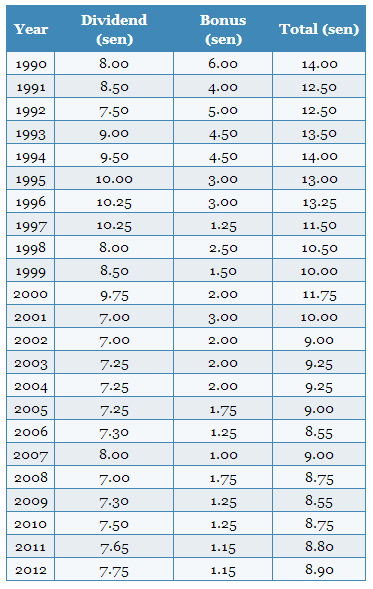A Merry Christmas and A Happy New 2014 Year from Invest Made Easy
We hope all your financial goals will be achieved and all investments turn fruitful!
 |
| IRR = 3.62% |
 |
| Historical Dividend courtesy of 1-Million-Dollar-Blog |
 |
| OCBC MaxEdu Choice - Click to Enlarge |
 |
| Click to Enlarge |
 |
| Top 10 Best Performing Unit Trust Fund (Equity Malaysia) |
Fund Name
|
YTD as of
9th Oct 2013 |
YTD as of
8th Nov 2013 |
4 Weeks
Gain / Loss (%) |
4 Weeks Gain/
Loss Rankings |
Previous
4 Weeks Gain/Loss Rankings |
Phillip Master Equity
Growth Fund
|
27.64
|
32.1
|
4.46
|
1
|
1
|
Kenanga Growth Fund
|
16.21
|
18.98
|
2.77
|
3
|
7
|
CIMB-Principal Wholesale
Equity Fund
|
16.05
|
20.5
|
4.45
|
2
|
5
|
MAAKL-HDBS Flexi Fund
|
13.27
|
15.13
|
1.86
|
5
|
4
|
CIMB-Principal Equity
Fund
|
16.25
|
18.52
|
2.27
|
4
|
2
|
Kenanga Syariah Growth
Fund
|
15.99
|
17.7
|
1.71
|
6
|
6
|
Hwang AIIMAN Growth
|
17.63
|
20.4
|
2.77
|
3
|
3
|
Public Focus Select Fund
|
Newcomer
|
7.91
|
N/A
|
N/A
|
N/A
|
Public Islamic
Opportunities Fund
|
Newcomer
|
24.58
|
N/A
|
N/A
|
N/A
|
Public Regular Savings
Fund
|
Newcomer
|
12.78
|
N/A
|
N/A
|
N/A
|
AVERAGE 4 WEEKS GAIN/LOSS (%)
|
2.90
|
||||
Fund Name
|
YTD as of
9th Oct 2013 |
YTD as of
8th Nov 2013 |
4 Weeks
Gain / Loss (%) |
4 Weeks Gain/
Loss Rankings |
Previous
4 Weeks Gain/Loss Rankings |
Public Islamic Asia
Dividend Fund
|
3.15
|
3.76
|
0.61
|
3
|
3
|
Pheim Asia Ex-Japan
Islamic
|
13.47
|
14.35
|
0.88
|
2
|
1
|
Public Asia Ittikal Fund
|
1.88
|
2.12
|
0.24
|
7
|
5
|
Public Regional Sector
Fund
|
15.26
|
15.36
|
0.1
|
9
|
7
|
PB Islamic Asia Equity
Fund
|
1.46
|
1.91
|
0.45
|
5
|
4
|
Eastspring Investments
Asia Pacific Shariah Equity Fund
|
-0.25
|
-0.07
|
0.18
|
8
|
6
|
Pheim Asia Ex-Japan
|
2.67
|
3.22
|
0.55
|
4
|
N/A
|
CIMB Islamic Asia Pacific
Equity Fund
|
3.15
|
4.56
|
1.41
|
1
|
8
|
MAAKL Pacific Fund
|
4.21
|
4.59
|
0.38
|
6
|
2
|
Public Far-East Select
Fund
|
9.36
|
8.67
|
-0.69
|
10
|
N/A
|
AVERAGE 4 WEEKS GAIN/LOSS (%)
|
0.41
|
||||
|
Fund Name
|
YTD as of
9th Oct 2013 |
YTD as of
8th Nov 2013 |
4 Weeks
Gain / Loss (%) |
4 Weeks Gain/
Loss Rankings |
Previous
4 Weeks Gain/Loss Rankings |
|
CIMB-Principal Greater
China Equity Fund
|
7.73
|
7.02
|
-0.71
|
4
|
2
|
|
PB China Pacific Equity
Fund
|
9.3
|
8.26
|
-1.04
|
7
|
6
|
|
Public China Ittikal Fund
|
6.57
|
6.18
|
-0.39
|
1
|
5
|
|
Public China Select Fund
|
10.08
|
9.12
|
-0.96
|
5
|
4
|
|
PB China Titans Fund
|
4.53
|
3.88
|
-0.65
|
3
|
8
|
|
MAAKL Greater China Fund
|
2.54
|
1.55
|
-0.99
|
6
|
7
|
|
AmIslamic Greater China
|
-2.67
|
-3.31
|
-0.64
|
2
|
3
|
|
Eastspring Investments
Dinasti Equity Fund
|
5.69
|
3.8
|
-1.89
|
8
|
9
|
|
Hwang China Select Fund
|
17.91
|
15.43
|
-2.48
|
9
|
1
|
|
Manulife Investment -
China Value Fund
|
Newcomer
|
7.61
|
N/A
|
N/A
|
N/A
|
|
AVERAGE 4 WEEKS GAIN/LOSS (%)
|
-1.08
|
||||